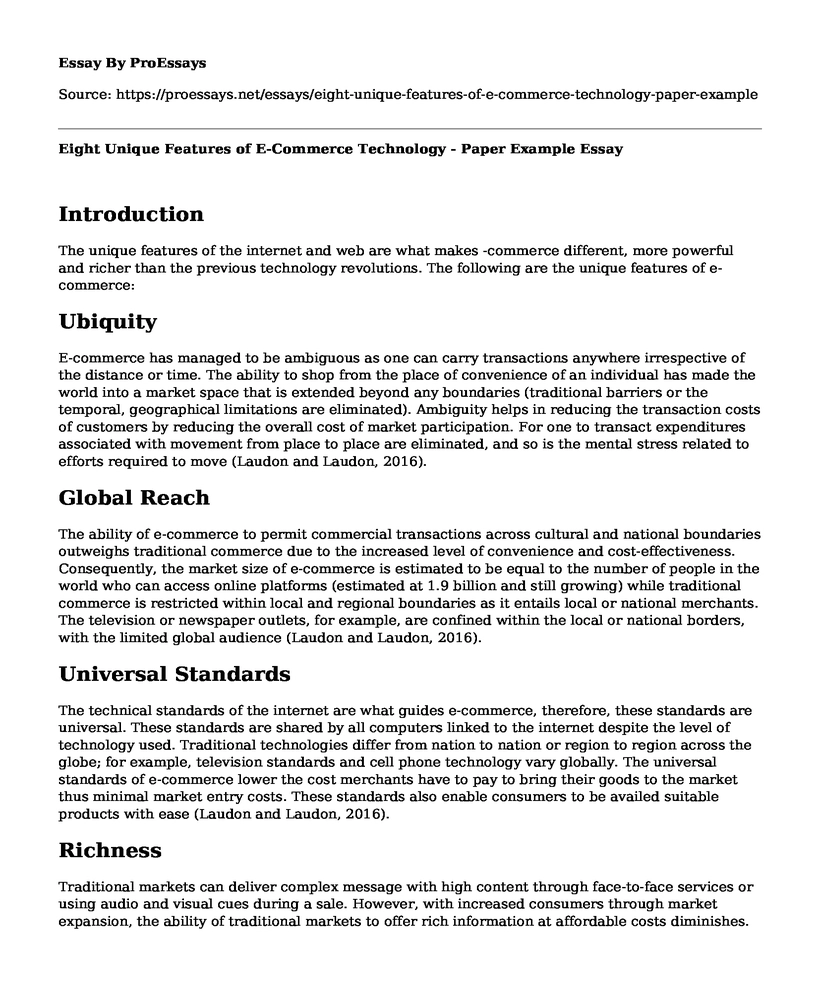Introduction
The unique features of the internet and web are what makes -commerce different, more powerful and richer than the previous technology revolutions. The following are the unique features of e-commerce:
Ubiquity
E-commerce has managed to be ambiguous as one can carry transactions anywhere irrespective of the distance or time. The ability to shop from the place of convenience of an individual has made the world into a market space that is extended beyond any boundaries (traditional barriers or the temporal, geographical limitations are eliminated). Ambiguity helps in reducing the transaction costs of customers by reducing the overall cost of market participation. For one to transact expenditures associated with movement from place to place are eliminated, and so is the mental stress related to efforts required to move (Laudon and Laudon, 2016).
Global Reach
The ability of e-commerce to permit commercial transactions across cultural and national boundaries outweighs traditional commerce due to the increased level of convenience and cost-effectiveness. Consequently, the market size of e-commerce is estimated to be equal to the number of people in the world who can access online platforms (estimated at 1.9 billion and still growing) while traditional commerce is restricted within local and regional boundaries as it entails local or national merchants. The television or newspaper outlets, for example, are confined within the local or national borders, with the limited global audience (Laudon and Laudon, 2016).
Universal Standards
The technical standards of the internet are what guides e-commerce, therefore, these standards are universal. These standards are shared by all computers linked to the internet despite the level of technology used. Traditional technologies differ from nation to nation or region to region across the globe; for example, television standards and cell phone technology vary globally. The universal standards of e-commerce lower the cost merchants have to pay to bring their goods to the market thus minimal market entry costs. These standards also enable consumers to be availed suitable products with ease (Laudon and Laudon, 2016).
Richness
Traditional markets can deliver complex message with high content through face-to-face services or using audio and visual cues during a sale. However, with increased consumers through market expansion, the ability of traditional markets to offer rich information at affordable costs diminishes. The web, on the other hand, makes it possible for rich text messages, audio, and videos to simultaneously to large numbers of people within a short time (Laudon and Laudon, 2016).
Interactivity
E-commerce is more interactive compared to other traditional technologies (except telephone) as buyers and sellers can freely interact and communicate. Televisions, for example, do not allow interaction of buyers and sellers freely and neither can one fill in necessary details. The level of interaction in e-commerce is similar to face-face interactions but on a global scale (Laudon and Laudon, 2016).
Information Density
The total amount of quality information that can be accessed by all participants in e-commerce is vast compared to the data available from traditional markets. With e-commerce technologies reducing collection, processing, storage, and communication costs the currency, timeliness and accuracy of the information are increased. Information density in e-commerce effortlessly facilitates consumers with relevant cost and price data on products they require. Merchants are also able to understand more about consumer patterns and needs thus enabling market segmentation depending consumer capability to acquire specific services.
Personalization/Customization
Personalization is possible in e-commerce as messages can be altered based on past purchases, interests or name of consumers. The product can also be customized based on user preferences (Laudon and Laudon, 2016). Personalization and customization in e-commerce are aided by the large information density which provides a platform to gather consumer data an aspect that lacks in traditional markets. For example, one can only select the television channel they want to view, but content control is not an option, however, with online magazines and streaming services, one can choose a preferred program and even set alerts to be notified when specific programs or events happen.
Social Technology
The internet and e-commerce technologies have facilitated user content and social networking where an individual can create and share personal information with [people of their interest or the entire world. These messages can also be customized in various form (text, photos videos, music) and used to create new and strengthen existing networks. The latter is different from previous technologies such as the printing press or televisions where the experts generate content and share via media to serve vast audiences. E-commerce technologies have facilitated users to have a choice of what they need to consume (Laudon and Laudon, 2016).
References
Laudon, K. C., & Laudon, J. P. (2016). Management information systems: managing the digital firm. Pearson.
Cite this page
Eight Unique Features of E-Commerce Technology - Paper Example. (2022, Jul 21). Retrieved from https://proessays.net/essays/eight-unique-features-of-e-commerce-technology-paper-example
If you are the original author of this essay and no longer wish to have it published on the ProEssays website, please click below to request its removal:
- Three Top Trends: Artificial Intelligence, Sandbox Evading Malware, and Ransomware
- Essay Sample on Driverless Cars: Autonomous Vehicles of the Future?
- Research Paper on Nanotech: Revolutionizing Industries with Nanomaterials
- Essay Sample on Technology Displacing Human Workers: AI's Impact
- Essay Example on Unlimited Possibilities: The Cell Phone Revolution
- Essay Example on Introducing the iPhone SE: Price Skimming for Optimal Prices
- Essay Example on Will Humans Win the Race Against Machines? AI and the Digital Revolution







